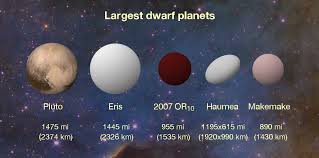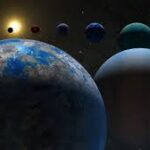Dwarf planets have become a topic of great interest and curiosity among astronomers and space enthusiasts. Although they share some similarities with the classical planets, dwarf planets occupy a unique category in our solar system. With the reclassification of Pluto in 2006, the term “dwarf planet” came into widespread use, reshaping our understanding of celestial bodies orbiting the Sun. In this 1000-word article, we’ll explore what dwarf planets are, how they differ from regular planets, and why they are important in the broader context of space science.
What Is a Dwarf Planet?
- Orbits the Sun.
- Has sufficient mass for its self-gravity to overcome rigid body forces and achieve a nearly round shape.
- Has not cleared its neighboring region of other objects.
- It is not a satellite (i.e., it does not orbit another non-stellar object like a moon does).
The key distinction between a dwarf planet and a traditional planet is the inability of dwarf planets to “clear the neighborhood” around their orbit. This means they share their orbital zones with other bodies of similar size.
History and Origin of the Term
The need for a new classification arose in 2006, after the discovery of Eris, a trans-Neptunian object that was found to be slightly smaller in diameter but more massive than Pluto. This prompted a debate over what constitutes a planet. Famous Dwarf Planets in Our Solar System
There are currently five officially recognized dwarf planets by the IAU, though there may be hundreds more waiting to be confirmed. These include:
1. Pluto
- Location: Kuiper Belt
- Diameter: About 2,377 km
- Moons: 5 (including Charon, its largest)
- Notable for: Being the most famous and formerly considered the ninth planet.
2. Eris
- Location: Scattered Disc (a distant part of the Kuiper Belt)
- Diameter: About 2,326 km
- Moons: 1 (Dysnomia)
- Notable for: Sparking the debate that led to Pluto’s reclassification.
3. Haumea
- Location: Kuiper Belt
- Diameter: About 1,632 km (elongated shape)
- Moon
4. Makemake
- Location: Kuiper Belt
- Diameter: About 1,430 km
- Moons: 1 known moon
- Notable for: Being the second-brightest Kuiper Belt object after Pluto.
5. Ceres
- Location: Asteroid Belt (between Mars and Jupiter)
- Diameter: About 940 km
- Moons: None
Dwarf Planets vs. Planets: Key Differences
Feature Planet Dwarf Planet
Orbits the Sun Yes Yes
Nearly round shape Yes Yes
Cleared orbit Yes No
Moons Yes (most have) Yes (some have, some don’t)
Examples: Earth, Mars, Jupiter, Pluto, Eris, Haumea, Makemake, Ceres
The Importance of Studying Dwarf Planets
Dwarf planets, despite their smaller size, offer valuable insights into the early solar system. Here’s why they matter:
- Primordial Objects: Many dwarf planets are thought to be remnants from the early solar system, making them excellent candidates for studying planetary formation.
- Geological Activity: Some dwarf planets like Pluto and Ceres have shown evidence of geological activity, suggesting they may harbor subsurface oceans.
- Astrobiology: The potential for liquid water and organic compounds on these worlds raises exciting possibilities about the existence of microbial life.
- Expanding Our Knowledge: Every mission to these distant objects (like NASA’s New Horizons to Pluto and Dawn to Ceres) has added depth to our understanding of the complexity and diversity of solar system bodies.
Future Exploration of Dwarf Planets
With the success of past missions, space agencies are increasingly focusing on dwarf planets. Proposed or upcoming missions include:
- NASA’s Dragonfly mission to Saturn’s moon Titan (not a dwarf planet but a similar icy world).
- A potential orbiter to Pluto in the 2030s to follow up on the New Horizons flyby.
- ESA’s Hera mission to the asteroid system Didymos (again, not a dwarf planet, but part of the broader effort to explore small bodies).
These missions aim to unlock more secrets hidden in the outer reaches of our solar system.
How Many Dwarf Planets Are There?
While only five have been officially classified, astronomers estimate there could be 200 or more dwarf planets in the Kuiper Belt alone and possibly over 10,000 beyond it. As telescope technology improves and new space telescopes like the James Webb Space Telescope (JWST) are deployed, we are likely to discover many more.
Conclusion
Dwarf planets, though small in size, play a big role in shaping our understanding of the cosmos. They bridge the gap between small rocky asteroids and full-fledged planets, offering clues about the solar system’s birth and evolution. As technology advances, we’re likely to uncover many more of these distant worlds and learn more about their composition, structure, and potential to support life.
Whether it’s the icy plains of Pluto, the rocky surface of Ceres, or the mysterious dark world of Eris, dwarf planets continue to captivate our imagination and challenge our definitions of what it means to be a planet. They remind us that size isn’t everything and that even the smallest members of the solar system family have important stories to tell.



